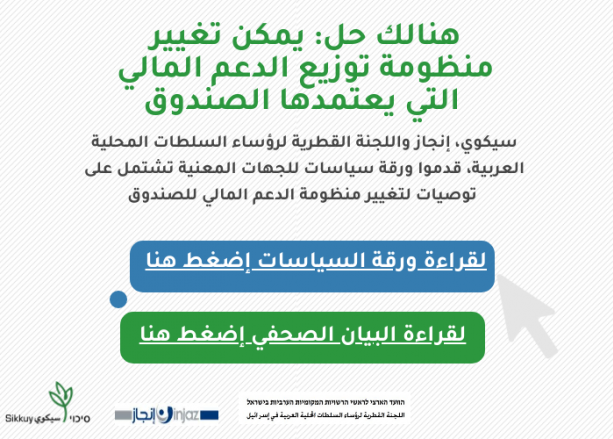Sikkuy – the shared Jewish and Arab nonprofit organization for advancing equality and partnership in Israel , Injaz -the professional development force engine of the Arab local authorities, and the Committee of Heads of Arab Local Authorities, published a new research on the gap reduction fund, to show that the fund did not succeed in achieving its goals and that gaps still exist between Arab and Jewish local authorities. The Arab local authorities receive only 30% of the budget of this fund, which amounts to 500 million shekels, a portion of which has been distributed so far, and the rest will be distributed until 2026.
The Gap Reduction Fund was established in 2017, and it was supposed to transfer a part of the government city taxes to the weaker local authorities, including the Arab local authorities, to overcome the main problem in the current reality, which is the deep gap in the revenues of the local authorities resulting from the lack of commercial and government city tax. This problem arose in the Arab local authorities due to the blatant discrimination against Arab towns in the allocation of land budgets, including the allocation by the government of few spaces for the establishment of industrial and commercial centers within the Arab towns, and the lack of state institutions and government offices in these areas
Exclusionary Criteria
According to the research, there are a number of exclusionary criteria that the fund follows to support local authorities in the country. But 4 out of 9 criteria, relating to more than 40% of the budget, lean in favor of Jewish towns.
According to the first criterion, towns receive government financial support if they accommodate 2% or more of the new arrivals (Jewish immigrants). The second criterion stipulates that at least 100 citizens of Ethiopian descent should live in the town. The third criterion deals with “positive migration”, that is, towns where the number of incoming residents exceeds the number of outgoing residents, as a condition for receiving part of the budgets. Therefore, all these criteria are inappropriate for Arab local authorities.
The fourth criterion concerns the rate of Arnona (city tax) collection, which also discriminates against weak local authorities, especially Arab ones. As part of its criteria, the fund considered supporting local authorities where the Arnona collection rate reaches a minimum of 75%. However, weak local authorities do not manage to reach such a collection rate, and Arab local authorities make up a large part of the weak local authorities in the country, 95% of which fall within the lower grades of the socio – economic classification (clusters 1-5), so it is the richer local authorities that ultimately receive support according to this criterion.
Adopting a single standard to reduce gaps
The research partners call on the relevant government agencies to distribute the fund’s budgets fairly by changing the fund’s system to support local authorities. The partner institutions demand that the income of local authorities from commercial Arnona be adopted as the only and basic criterion to determine which of the local authorities will receive support from the fund and what is the amount of support, which will enable Arab local authorities to increase their sources of income from the fund, and thus provide better services to their residents.





